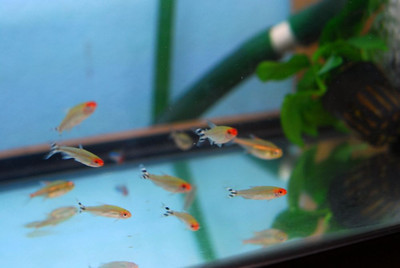Rummynose Tetra
Posted by Max Gandara on on 30th Apr 2025
Rummynose Tetra
Welcome to our aquatic adventure as we dive deep into the fascinating world of the Rummynose Tetra! This small yet captivating fish is a favorite among aquarium enthusiasts for its striking appearance and peaceful nature. In this blog, we’ll explore everything you need to know about this delightful species, from its origins and natural habitat to care tips and tank setup.
Origins and Natural Habitat
The Rummynose Tetra (scientific name: Hemigrammus rhodostomus) hails from the tropical regions of South America, primarily found in the Amazon River Basin. These fish thrive in slow-moving waters with dense vegetation, which provides excellent cover and breeding grounds. Their native environment is characterized by soft, acidic water, which is something you’ll want to replicate in your home aquarium for their well-being.
Appearance and Behavior
Rummynose Tetras are easily recognized by their unique coloration. They possess a shimmering silver body with a distinctive red patch on their head, resembling a "rummy nose." Adding to their charm, their tails are adorned with black and white stripes.
These fish are renowned for their schooling behavior, often moving together in perfect harmony. Their peaceful nature makes them an ideal addition to community tanks, as they coexist well with other non-aggressive species.
Tank Setup and Requirements
To ensure your Rummynose Tetras thrive, it’s essential to mimic their natural habitat as closely as possible. Here's a checklist to help you set up the perfect tank:
-
Tank Size: A minimum of 20 gallons is recommended for a small school of Rummynose Tetras. They appreciate ample swimming space.
-
Water Conditions: Aim for a temperature between 75-82°F (24-28°C), with a pH level of 5.5-7.0. Soft, slightly acidic water is ideal.
-
Filtration and Aeration: A gentle filtration system is crucial to maintain water quality, along with adequate aeration to ensure oxygenation.
-
Substrate and Decor: Use a dark substrate to highlight their vibrant colors. Add plenty of plants, driftwood, and rocks to provide shelter and mimic their natural habitat.
-
Lighting: Moderate lighting will suffice, allowing plants to thrive without stressing the fish.
Diet and Feeding
Rummynose Tetras are omnivorous, meaning they enjoy a varied diet. In the wild, they feed on small insects, larvae, and plant matter. In captivity, a balanced diet can include:
-
Flake Food: High-quality flake food designed for tropical fish.
-
Live or Frozen Food: Offer brine shrimp, daphnia, or bloodworms as occasional treats.
-
Vegetables: Blanched spinach or lettuce can supplement their diet.
Feed small amounts two to three times daily, ensuring food is consumed within a few minutes to prevent waste accumulation.
Breeding Rummynose Tetras
Breeding Rummynose Tetras can be a rewarding experience for enthusiasts. To encourage spawning, provide optimal water conditions and a separate breeding tank. A slight increase in temperature and the introduction of live food can stimulate breeding behavior. Watch for the female’s rounded abdomen, indicating readiness to breed.
Once the eggs are laid, remove the adults to prevent them from eating the eggs. Fry will hatch in a few days and can be fed infusoria or finely crushed flake food.
Common Health Issues
Like all fish, Rummynose Tetras are susceptible to certain health issues. Regular monitoring and maintaining optimal water conditions are crucial to prevent disease. Common ailments include:
-
Ich: Characterized by white spots on the body, often caused by poor water conditions.
-
Fin Rot: A bacterial infection that can occur due to stress or injury.
Prompt treatment is essential, often involving water changes, medication, and isolation of affected fish.
Conclusion
The Rummynose Tetra is a delightful addition to any home aquarium, offering beauty and tranquility with their graceful movements and vivid colors. By understanding their needs and providing a suitable environment, you can enjoy the company of these charming fish while contributing to their well-being. Happy fishkeeping!

